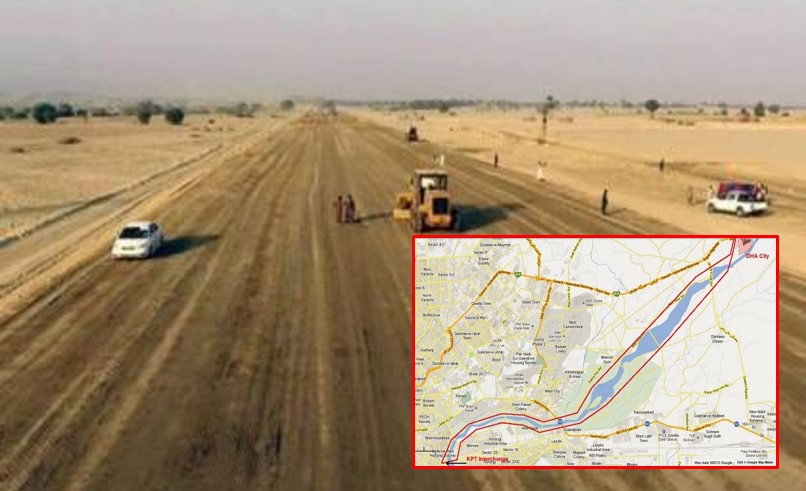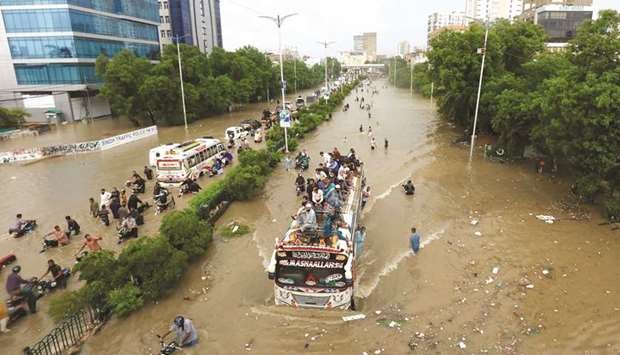30 April 2023
ADB withdraws from financing Malir Expressway
In a substantial move, the Asian Development Bank (ADB) has taken off the controversial Malir Expressway project for its priority lists for funding through ADB resources. In a letter to Indigenous Legal Rights Alliance (ILRA), the ADB writes that the project is not eligible for consideration under the ADB Accountability Mechanism owing to the climate change risks. The ILRA is a group of people affected by the Malir Expressway project and it lodged a complaint with the ADP about the adverse environmental impact of the expressway on behalf of the affected people. However, Sindh government spokesperson and Chief Minister`s Law Adviser Barrister Murtaza Wahab maintains the Malir Expressway is a public-private partnership project and not financed by the ADB.

In an earlier development this week, the Sindh Environmental Protection Tribunal has linked the Environmental Impact Assessment (EIA) approval of the Malir Expressway project with implementation of certain conditions including mitigating the risk of urban flooding, transparent acquisition of land for the project and to address the grievances of affected people. However, the tribunal noted that it was not inclined to set aside the EIA approval accorded by the Sindh Environmental Protection Agency (Sepa) or to stop the construction work as the project was in the larger interest of public. The tribunal also directed the Sindh government to constitute a complaint redressal & implementation committee within a month to monitor the project, implement the conditions and consider the complaints of affectees as well to advice Sepa to cancel EIA approval if the conditions were not implemented.
Land Case of Bahria Town Karachi 2
A division bench of the Sindh High Court comprising Justice Mohammad Junaid Ghaffar and Justice Adnanul Karim Memon resumed the hearing of the Bahria Town Karachi 2 (BTK 2) case this week at the Circuit bench, Hyderabad. In the hearing Additional Advocate General filed comments on behalf of the Sindh forest secretary as well as a statement of Senior Member Board of Revenue (SMBR) regarding “mother entries of the land”, informing the Court that the actual site position of the BTK-2 could only be determined after a survey and establishing latest ownership of the land in each Deh. Earlier the forest secretary had informed the SHC that the “BTK-2 has been approved wrongly by the Sindh Building Control Authority (SBCA) and Sehwan Development Authority (SDA) on forest lands as evident from attested maps”. However, taking a different position from what he had stated in the earlier hearing, the forest secretary states now in the comments: “Actual site position with latest entries could only be determined after survey of total lands of Dehs by earmarking lands on ground and maps as per latest ownership of land in each Deh. Prima facie land in dispute with regard to petition doesn`t fall within protected forests.”

In the stated case, a petitioner moved the SHC stating that BTK-2 is located close to PAF Base Bholari on Karachi-Hyderabad side of M-9 close to highly sensitive defence installations, therefore it undermines and compromises defence of the country. He asked the court to form a joint investigation team to physically survey and investigate title and ownership of the land on which BTK-2 layout plan was drawn. The forest secretary maintains now “Any changes in the status of land due to allotment is done by BoR. Change in ownership and its subsequent entries are registered by relevant officers of BoR and land record. Thus forest department is not in a position to determine latest entry position in record of rights of above mentioned Dehs”. The court adjourned the hearing till May 23.
Plight of Pakistan’ Steel Sector
Iron and steel are considered as the base material for the growth of an economy. However, imports of steel and scrap iron fell by over 50% this fiscal year, according to the data issued by the State Bank of Pakistan (SBP). The low import indicates the low consumption of iron and steel which has also impacted the entire industrial sector including the construction industry as their prices had gone up to a record high with more than 100% increase within a year. The data also showed that the import of scrap iron and steel fell by 50.6% to $859.3 million in the first nine months of FY23 against $1,739.5m during the same period last year. Further details disclosed that the import of iron and steel (finished product) fell by 36.6% during 9MFY23 to $1,321m against $2,085m last year.

The sharp decline in the consumption of steel is also visible from the 11.59% year-on-year decline in the Large-Scale Manufacturing sector in February. According to a detailed study conducted by Pakistan Credit Rating Agency (PACRA), steel consumption in Pakistan has been declining for the last five years, while the per capita consumption in Pakistan was much below the world average. The world average per capita consumption of steel is recorded at around 233kg. Pakistan`s per capita consumption is lower than its neighbouring country, India with 76Kg.
Pakistan`s annual steel products demand hovers around 13.5 million tonnes in FY22. Almost 73% of the country`s demand is met through local production and the rest through imports. The major raw material used in the steel industry is iron scrap. Pakistan is an importer of raw iron and steel scrap. Although the country produces around a million tonnes of iron ore every year, however, Pakistan imports finished steel to cater to the industry demand. The country`s steel sector is largely competitive with 173 players registered with the Pakistan Steel Re-Rolling Mills Association and majorly driven by private corporations. Pakistan Steel Mills (PSM) a state-owned giant with a capacity of 1.1m tons has remained inactive since June 2015.
Pakistan at risk of “Excessive Rain”
According to a report prepared by the Global Information and Early Warning System (GIEWS) of the Food and Agriculture Organisation (FAO) of the United Nations Pakistan is among the 20 countries which are at risk of excessive rainfall as the El Nino oceanographic phenomenon forecast returns in June following three years of La Nina. While 20 countries are at risk of excessive rainfall, 42 countries are also at risk of the effects of El Nino with the risk of dry conditions, the report says. The report released this week aimed to highlight countries where El Nino-induced dry weather conditions could occur and have an adverse impact on cereal production in 2023-24, potentially aggravating local food insecurity. Forecast to return in June 2023, the El Nino oceanographic phenomenon is a key driver of extreme weather events that pose high risks to global food security.

On the other hand, amid the forecast of heavy rains across the country between April 26 and May 7, Minister for Climate Change Senator Sherry Rehman has advised the provinces to take necessary precautions and stay alert to ensure public safety during this period while expressing the apprehension that the country might “fall into a recovery trap”. From Kashmir to Karachi, according to her, one must be prepared to expect unstable weather patterns leading to sporadic urban flooding. The Met Office earlier cautioned tourists, farmers and relevant authorities that strong wind and hail-storm may cause damage to lose infrastructure and standing crops (particularly wheat crop), while heavy showers may trigger flashfloods and urban flooding in various cities of the country.


